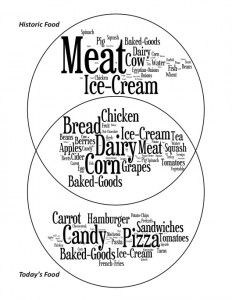Cooking and eating meals can be a deeply personal experience. Families and friends connect and build memories and traditions over food. A bite or smell of a familiar dish can bring up powerful memories. However, many people today, especially children, are completely disconnected from the natural, seasonal cycle of food and the daily task of cooking. How can we as educators in historic institutions help visitors overcome these barriers and help our visitors connect to people who lived hundreds of years ago?
 In 2012, I began working on finding an answer to this question with my master’s thesis. I chose to focus specifically on children’s experiences in historic house gardens, and what they may learn about food after participating in programming. I conducted research at 5 historic homes in the Philadelphia area. Each group of children I surveyed had participated in hands-on programs that focused on edible plants growing on the property. I gave children a Venn diagram and asked them to identify food they saw that day that people today would eat, people in the past would eat, and people from both time periods would eat.
In 2012, I began working on finding an answer to this question with my master’s thesis. I chose to focus specifically on children’s experiences in historic house gardens, and what they may learn about food after participating in programming. I conducted research at 5 historic homes in the Philadelphia area. Each group of children I surveyed had participated in hands-on programs that focused on edible plants growing on the property. I gave children a Venn diagram and asked them to identify food they saw that day that people today would eat, people in the past would eat, and people from both time periods would eat.
The results of my survey showed that overall, children have a difficult time learning about food in a garden. When children think about food, no matter the time period, produce is not the first thing that comes to mind. This word cloud shows the frequency of different responses children gave. The larger the word, the more often it was recorded on the survey. In the past, people evidentially existed exclusively on meat and ice cream! Further analysis revealed that prepared foods were referenced more frequently (44% of all responses) than produce (34% of all responses). 
So why did this happen? I wonder if the educators themselves were assuming children were more familiar with produce than they actually were. Think about how kids typically interact with food. Their parents or other adults hand them a snack or place a plate in front of them at mealtime. Most kids really aren’t involved in any food preparation on a regular basis, so they rarely see the “raw” form of fruits and veggies. Many adults don’t cook, and they don’t share those skills or interests with their children. Seeing a plant – a collection of leaves, stems, flowers, and fruit that appear at different times throughout the growing season – might be confusing to children who only see food as a meal on a plate.
So how can we, as educators, work to better teach children about food in our gardens? The first step may be accurately establishing the level of prior knowledge your visitors have. Simply ask them at the start of your program, “Who here has gardened before?” or “What is your favorite vegetable? Do you know how it grows?” When you are teaching the program, keep this information in mind and create connections to the children’s prior knowledge.

Another technique might be to incorporate examples of fully-grown produce in a form the children may be familiar with. For example, if you grow corn in your garden, have an example of it, both on the cob and canned. If they can connect what’s in the ground with what ends up on their plate your program may have more successful outcomes. Or better yet, find a way to let kids taste what they see! If you can’t share the produce your garden grows, what about buying something from the store to taste?
Ruth Lonvick is with the Hagley Museum and Library. If you have more questions about this topic, or are interested in reading her full thesis, “Growing History: A Study of Children’s Meaning Making in Historic House Gardens,” please feel free to contact her at [email protected].



